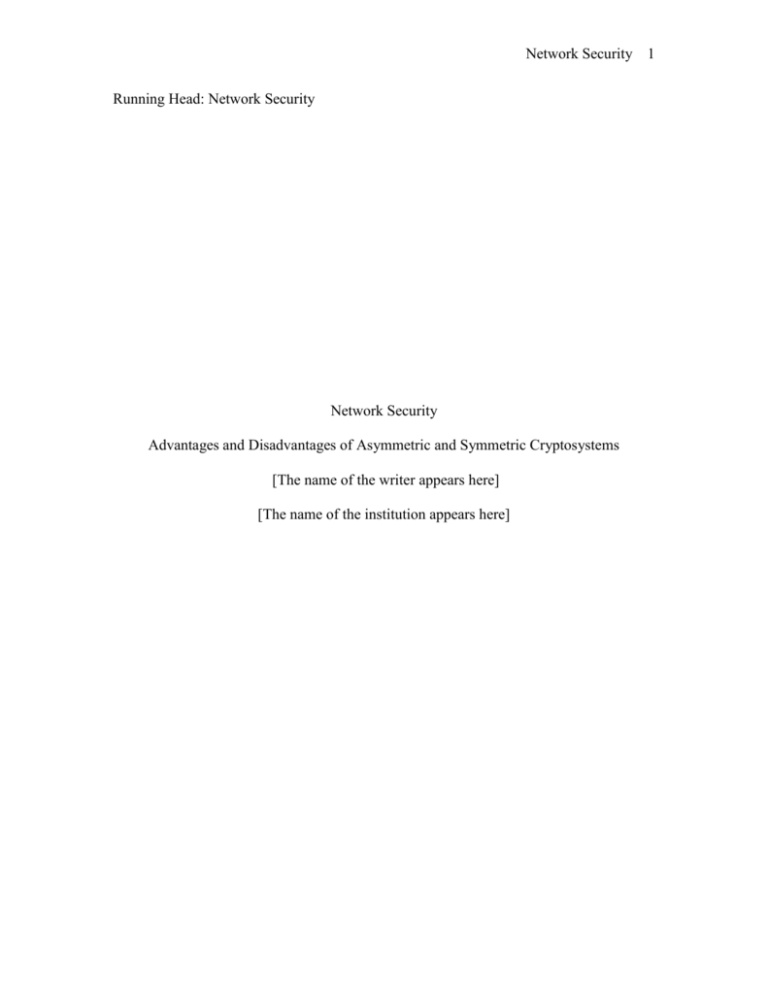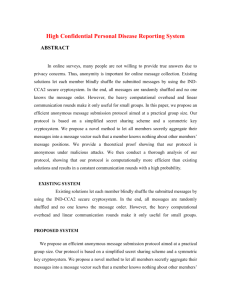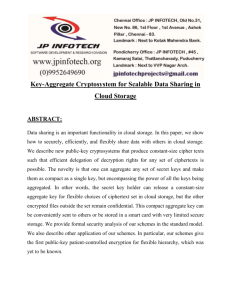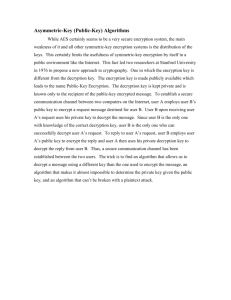Network Security – Advantages and Disadvantages of Cryptosystems
advertisement

Network Security 1 Running Head: Network Security Network Security Advantages and Disadvantages of Asymmetric and Symmetric Cryptosystems [The name of the writer appears here] [The name of the institution appears here] Network Security 2 CRYPTOSYSTEMS A cryptosystem (or cryptographic system) is the package of all procedures, protocols, cryptographic algorithms and instructions used for encoding and decoding messages using cryptography. [Wikipedia.com] As defined earlier, the system developed by implementing certain encoding/decoding techniques, cryptographic alogthims and procedures is referred to as the cryptosystem. Users interact with the cryptosystem to get the encryption or decryption done using the techniques and algorithms deployed in the system. A cryptosystem is usually a whole collection of algorithms in which the algorithms are labeled. These labels are referred to as “keys”. [Paolo Resmini – Standford University] The term ‘cryptographic system’ was formed from ‘cryptography’; the science behind information security techniques, which involves encryption and decryption. Cryptosystems can be of two types: Asymmetric Cryptosystems Symmetric Cryptosystems ASYMMETRIC CRYPTOSYSTEMS In an asymmetric cryptosystem (or public key cryptosystem), there are two different keys used for the encryption and decryption of data. The key used for Network Security 3 encryption is kept public and so as called public key, and the decryption key is kept secret and called private key. The keys are generated in such a way that it is impossible to derive the private key from the public key. The transmitter and the receiver both have two keys in an asymmetric system. However, the private key is kept private and not sent over with the message to the receiver, although the public key is. SYMMETRIC CRYPTOSYSTEMS A symmetric cryptosystem (or private key cryptosystem) uses only one key for both encryption and decryption of the data. The key used for encryption and decryption is called the private key and only people who are authorized for the ecryption/decryption would know it. In a symmetric cryptosystem, the encrypted message is sent over without any public keys attached to it. ADVANTAGES AND DISADVANTAGES OF SYMMETRIC CRYPTOSYSTEMS ADVANTAGES A symmetric cryptosystem is faster. In Symmetric Cryptosystems, encrypted data can be transferred on the link even if there is a possibility that the data will be intercepted. Since there is no key transmiited with the data, the chances of data being decrypted are null. Network Security 4 A symmetric cryptosystem uses password authentication to prove the receiver’s identity. A system only which possesses the secret key can decrypt a message. DISADVANTAGES Symmetric cryptosystems have a problem of key transportation. The secret key is to be transmitted to the receiving system before the actual message is to be transmitted. Every means of electronic communication is insecure as it is impossible to guarantee that no one will be able to tap communication channels. So the only secure way of exchanging keys would be exchanging them personally. Cannot provide digital signatures that cannot be repudiated ADVANTAGES AND DISADVANTAGES OF ASYMMETRIC CRYPTOSYSTEM ADVANTAGES In asymmetric or public key, cryptography there is no need for exchanging keys, thus eliminating the key distribution problem. The primary advantage of public-key cryptography is increased security: the private keys do not ever need to be transmitted or revealed to anyone. Can provide digital signatures that can be repudiated Network Security 5 DISADVANTAGES A disadvantage of using public-key cryptography for encryption is speed: there are popular secret-key encryption methods which are significantly faster than any currently available public-key encryption method. ROLES PLAYED BY CERTIFICATES AND THE PKI IN THE ENCRYPTION PROCESS Public key infrastructure (PKI) refers to a comprehensive system required to provide public key encryption, digital certificates, and digital signatures. PKIs are designed for key management in public-key cryptographic systems to provide the users with digital signatures, in order to stricken the security. PKI allows participants of secure communication to publish their public keys in authentic manner. PKI uses the digital signatures to attest the public key of individual entities. The Certification Authorities (CA) which play the central role in PKI, issue certificates signing the public key of the individual entities with the digital signatures created by encrypting the public key of the individual with its private key. The digital certificates contain the following information: Issuing Certificate Authority, Validity period of the certificate, the public key of the individual for which the certificate has been created and digital signature that can be used to verify the certificate. ANALYSIS OF THE SITUATION AT ABC COMPANY On the basis of study conducted on the above topic, a brief analysis of the given scenario is done and recommendations with proof are in the following text. Network Security 6 A private link allowing east coast staff access to transactional applications and databases residing on Midwest office servers For this particular situation, a secret key cryptosystem is better suited. As the link between the two office is private and no-other unidentified user is to access any of the stations transmitting data. Both offices are to agree on a secret key to be used for the data encryption and decryption. Being the faster of the two cryptographic methods, symmetric cryptosystem is more appropriate for transactional applications and database access. A planned Internet website on which customers can view their ordering and payment information, place new orders, and communicate to customer service representatives via e-mail A public key cryptosystem is suitable for this situation. As the public key system is more secure than the latter, our major concern is security of the consumer data while the information is on Internet. Since the public key cryptographic system can be deployed using PKI (Public Key Infrastructure) using digital signatures and separate public keys for each user, it is more reliable and authentic method well suited for the scenario under consideration. Network Security 7 REFERENCES Cryptosystems http://en.wikipedia.org/wiki/Cryptosystem Compare and Contrast of Symmetric Cryptosystems and Public-Key Cryptosystems By Miguel Hidalgo http://www.informweb.com/webportal/articles/pkicc.htm






